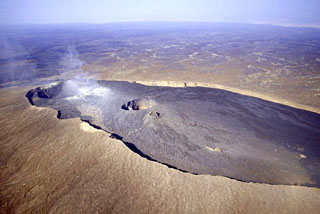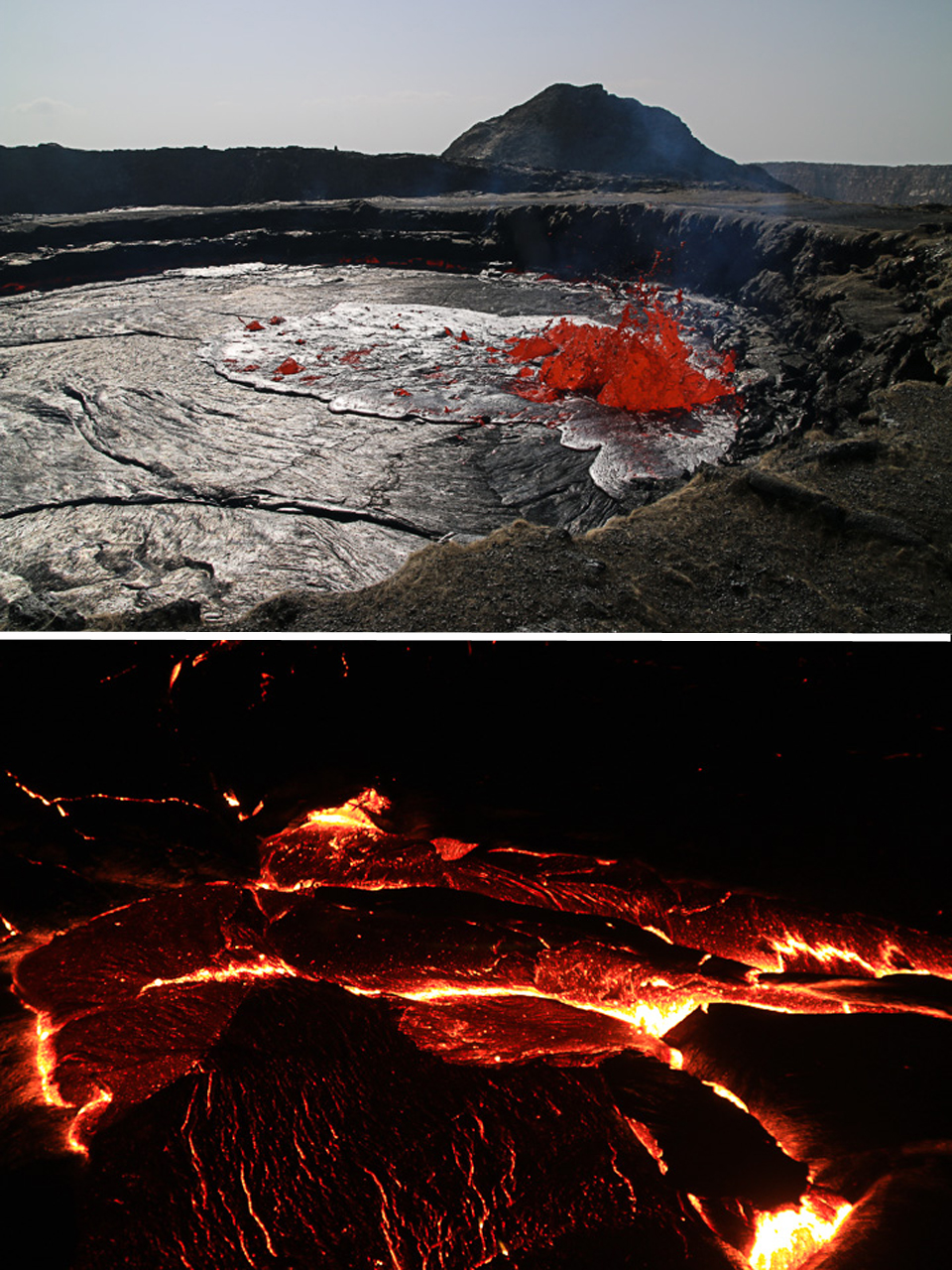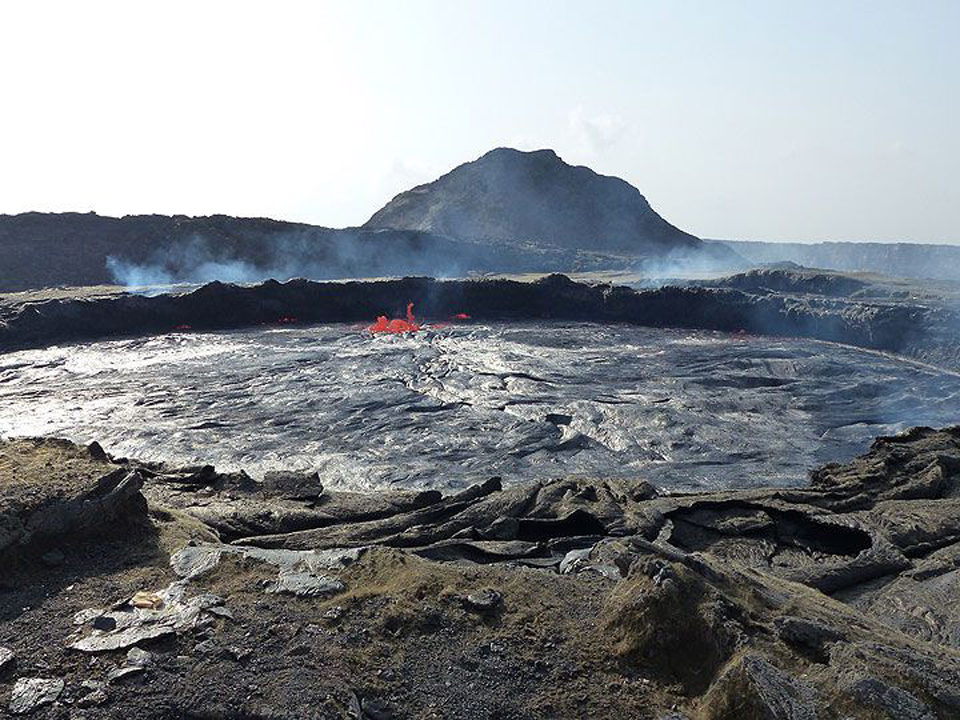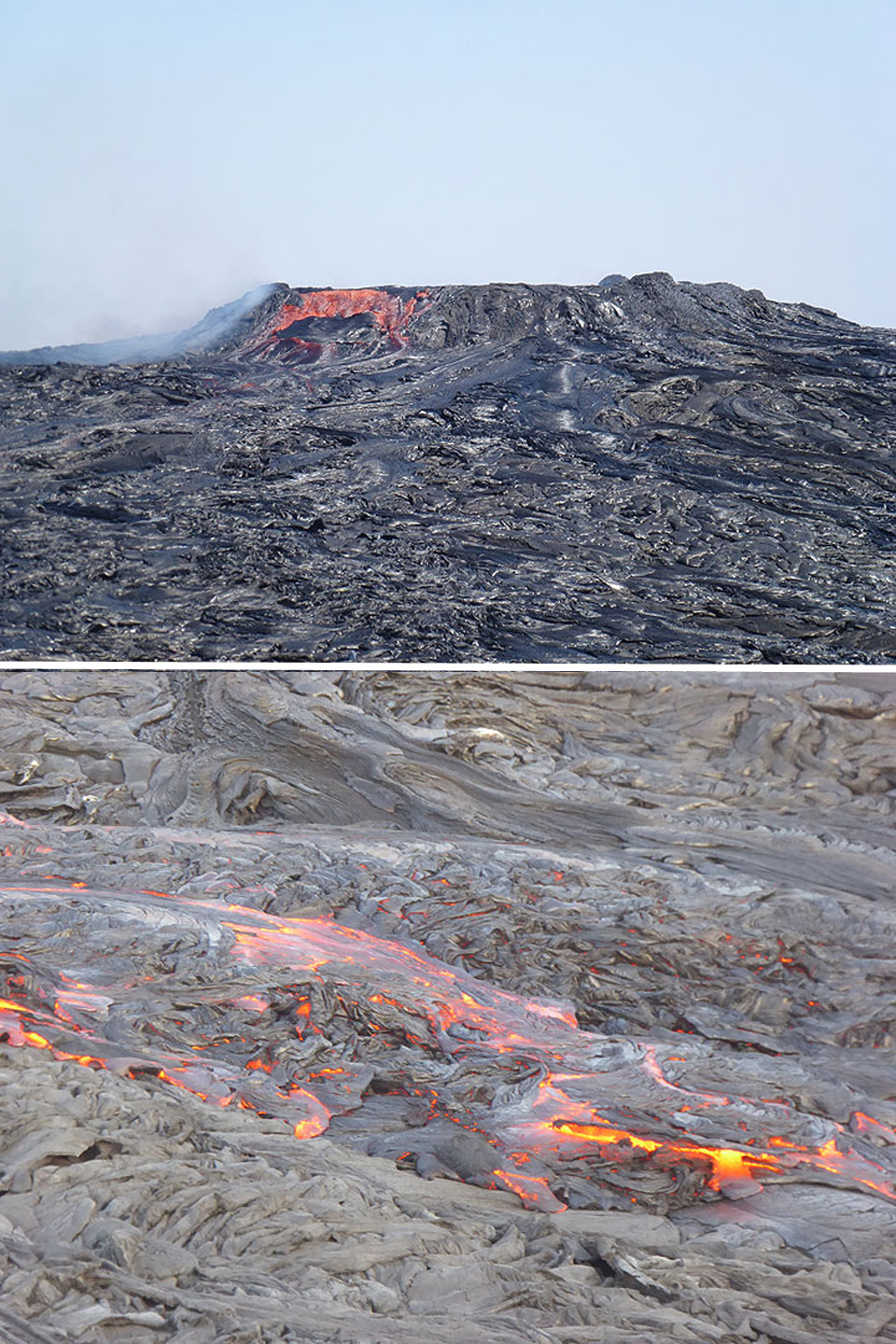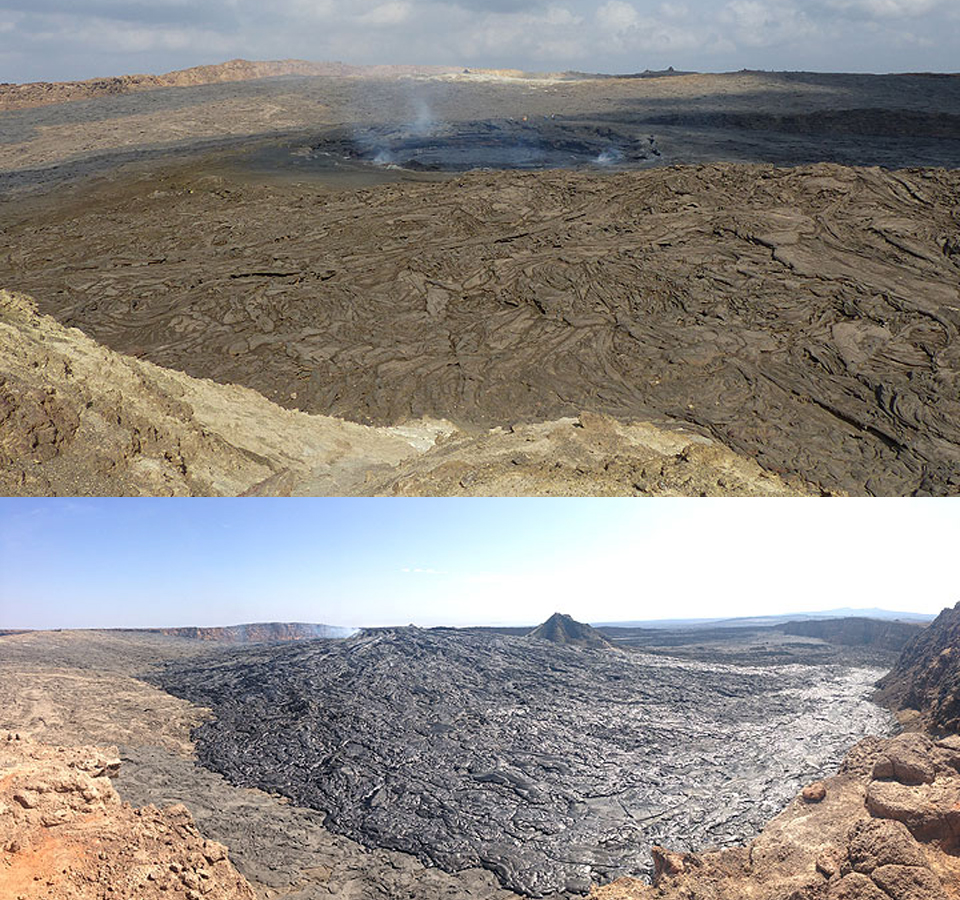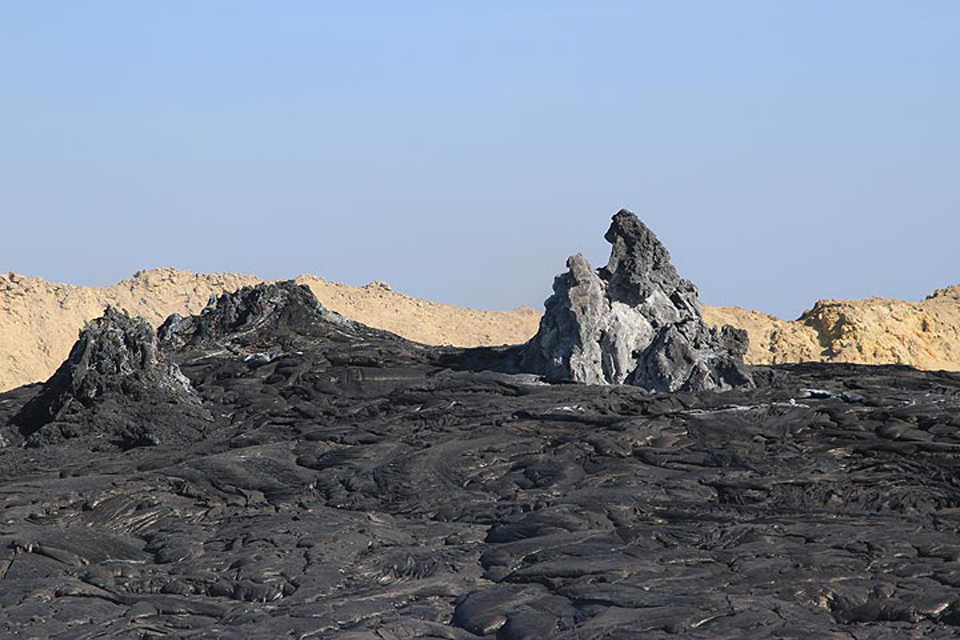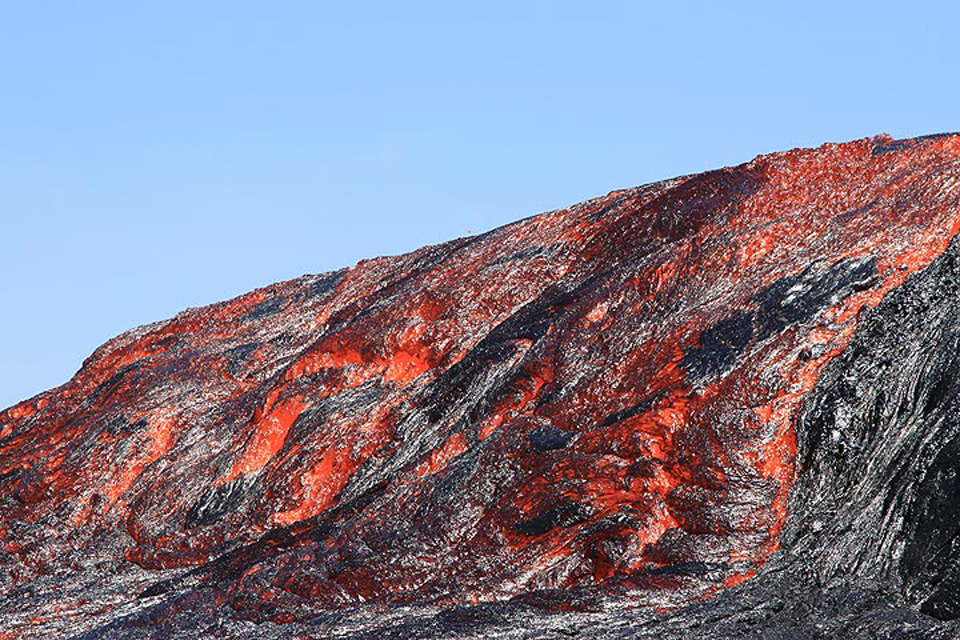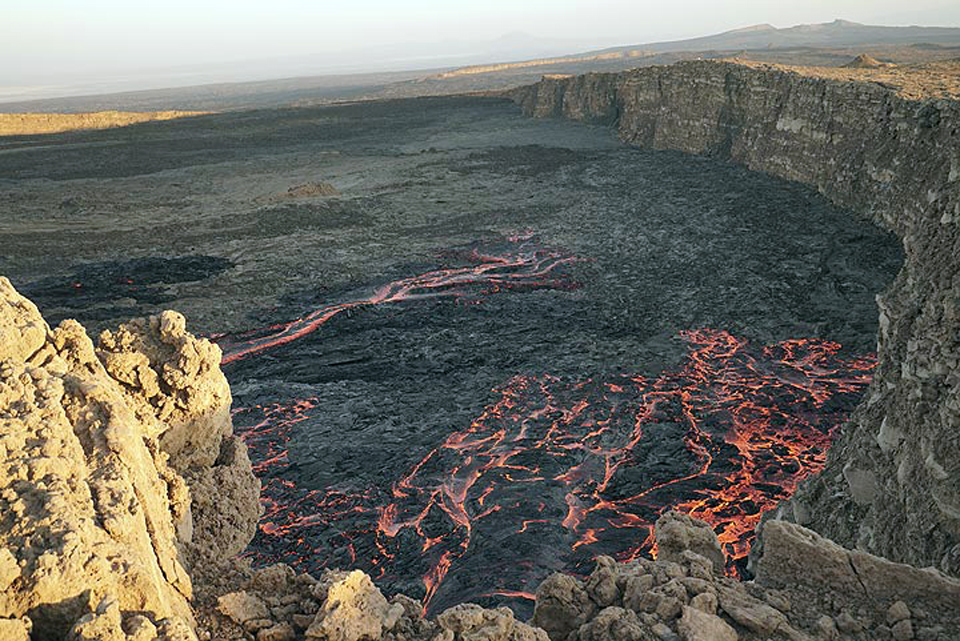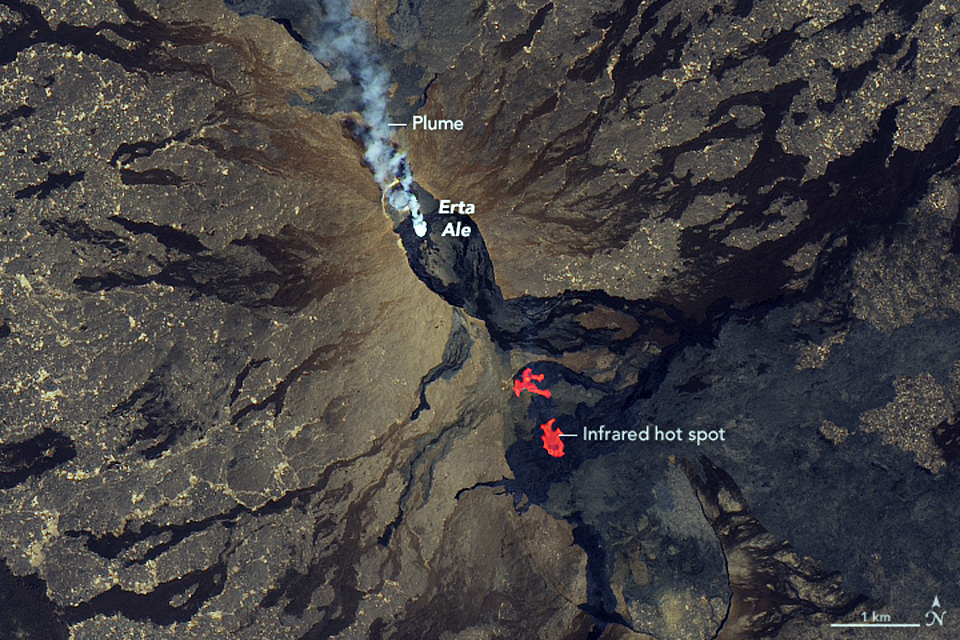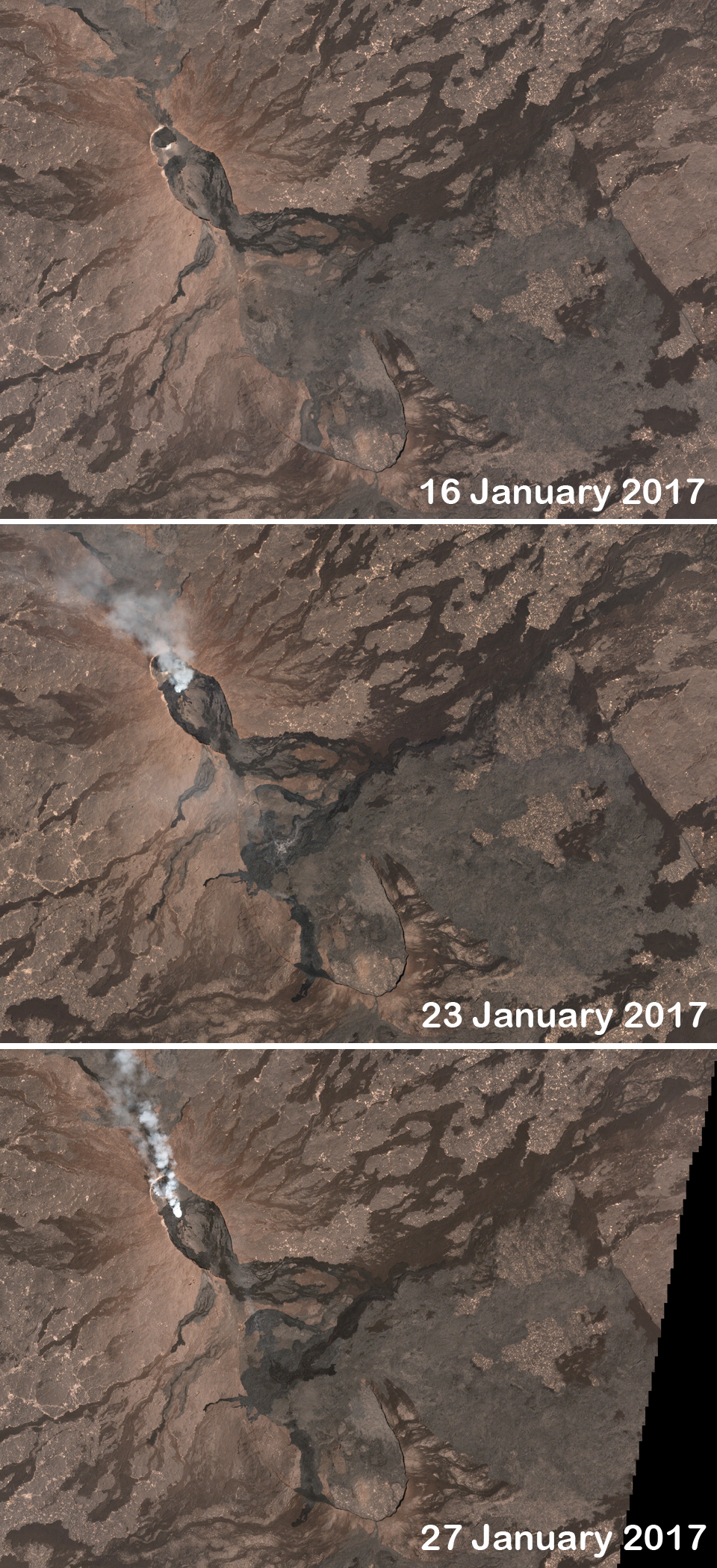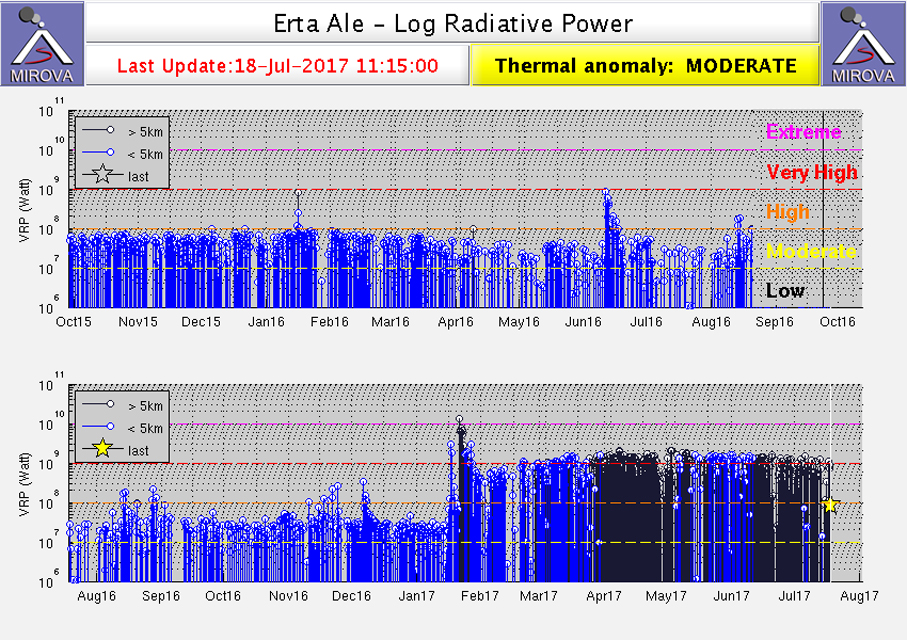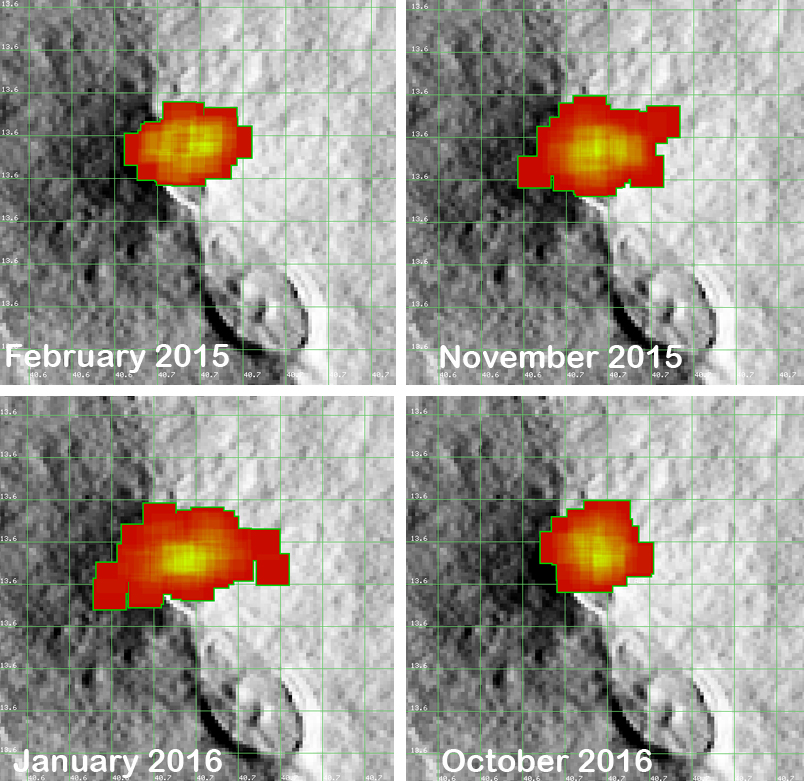Report on Erta Ale (Ethiopia) — July 2017
Bulletin of the Global Volcanism Network, vol. 42, no. 7 (July 2017)
Managing Editor: Edward Venzke.
Edited by A. Elizabeth Crafford. Research and preparation by Robert Andrews.
Erta Ale (Ethiopia) Persistent lava lake; crater rim overflows; new fissure eruption begins in January 2017
Please cite this report as:
Global Volcanism Program, 2017. Report on Erta Ale (Ethiopia) (Crafford, A.E., and Venzke, E., eds.). Bulletin of the Global Volcanism Network, 42:7. Smithsonian Institution. https://doi.org/10.5479/si.GVP.BGVN201707-221080
Erta Ale
Ethiopia
13.601°N, 40.666°E; summit elev. 585 m
All times are local (unless otherwise noted)
Ethiopia's Erta Ale basaltic shield volcano has had an active lava lake since the mid 1960s, and possibly much earlier. The first confirmed historical observations were in 1906. Two active craters (Northern and Southern) within a larger oval-shaped caldera exhibit periodic fountaining of lava causing lava lake overflows; this creates spectacular incandescence as the pahoehoe lava flows into the larger caldera around the craters and occasionally beyond. Lava flows in the South Pit crater overflowed its rim in November 2010 (BGVN 36:06). This report discusses activity from 2011 through June 2017, including the South Pit crater overflows in January and November 2016, and a new fissure eruption on the SE flank that began in January 2017 and was continuing in June 2017. Information comes from satellite thermal and visual data (NASA Earth Observatory, MODIS), and photographs from expeditions (primarily from Volcano Discovery) that regularly visit this remote site.
The lava lake at the South Pit crater in the summit caldera remained active, with the lake level falling and rising to within a few meters of the rim, during 2011-2015. Intermittent lava flows were reported from the North Pit Crater as well during this time. Activity increased late in 2015, and the first overflows of the South Pit crater rim since late 2010 occurred in mid-January 2016. It overflowed again in November 2016, and covered a significant area of the surrounding caldera floor with pahoehoe. By late December, effusive activity was reported from both craters. Flow intensity and volume increased dramatically for several days beginning on 17 January 2017, followed by ash emissions and crater collapses on 20-21 January. A new fissure eruption on the SE flank about 4 km from the caldera appeared on 21 January 2017, and sent lava flows several kilometers to the NE and the SW. Activity at the fissure vent increased during subsequent months, and by June 2017 a substantial new lava field that contained at least one new lava lake and flows more than 1,500 m long covered the area. Effusive activity had also resumed at both craters in the summit caldera.
Activity during November 2011-December 2016. Visitors in November 2011 confirmed the continued presence of the lava lake (figure 32) at the South Pit crater in the summit caldera. On 16 January 2012, an attack by Eritrean rebels on tourists camping at the S crater rim left at least five European tourists dead and seven others wounded; four Europeans and their Ethiopian guides were also abducted, according to Volcano Discovery reports. News reported through Volcano Discovery suggested that the abducted tourists were released in March 2012.
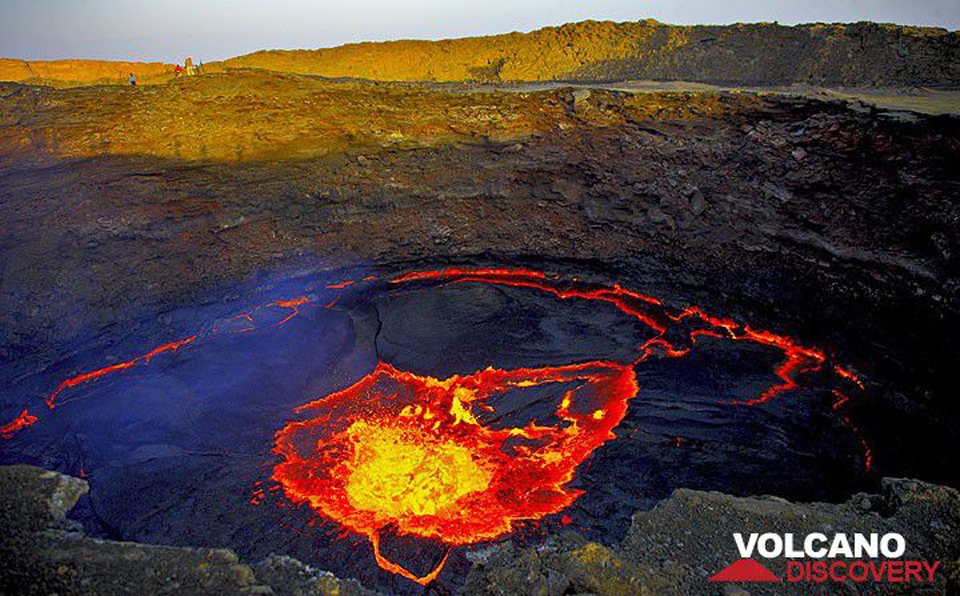 |
Figure 32. The active lava lake at Erta Ale's South Pit crater during November 2011. Photo by Reinhard Radke, courtesy of Volcano Discovery. |
Visitors in January 2013 reported that the lava lake in the North Pit crater was active and about 10 m below the rim. Intermittent lava flows were observed from a hornito in the South Pit crater and were continuing to fill the crater floor. Members of an expedition in December 2013 observed that the active lava lake at the South Pit crater had risen considerably during previous months (figure 33). An expedition in February 2015 also documented continued lava fountaining (figure 34) at the South Pit crater.
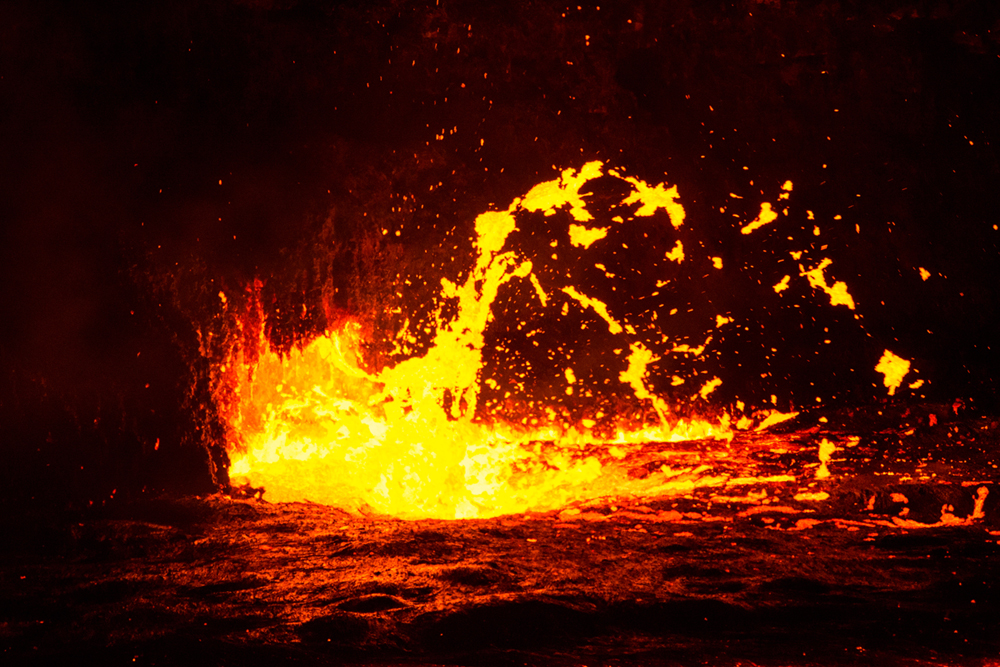 |
Figure 33. The active lava lake at the South Pit crater of Erta Ale in December 2013. Photo copyright by Dominique Voegtli, courtesy of Volcano Discovery, used by permission. |
During 19-21 November 2015, visitors on an expedition to Erta Ale observed significant changes in the lava lake level at the South Pit crater. On the morning of 19 November (figure 35) the lake surface was 2-3 m below the rim. A local guide reported that the lake had been very active during the previous weeks, rising to levels near overflowing similar to the event in late 2010. A second terrace of freshly cooled pahoehoe was visible less than 1 m below the rim, indicating the most recent maximum height of the lake. On 19 November, the lake rose to within 30 cm of the terrace rim, with occasional lava fountains splashing onto the terrace (figure 36), and Pele's hair forming continuously. The level had dropped several meters by the next morning. During 20 and 21 November, the activity was characterized by large, periodic "exploding bubbles" from the center of the lake creating waves across the surface; minor Strombolian activity and fountaining occurred around the edges. The lake level generally fluctuated between 0.5 and 1 m below the second terrace. On the evening of 21 November, the level rose rapidly from five to three meters below the second terrace; lava rapidly seeped out of the cracks in the cooling surface, overflowing onto the thin crust.
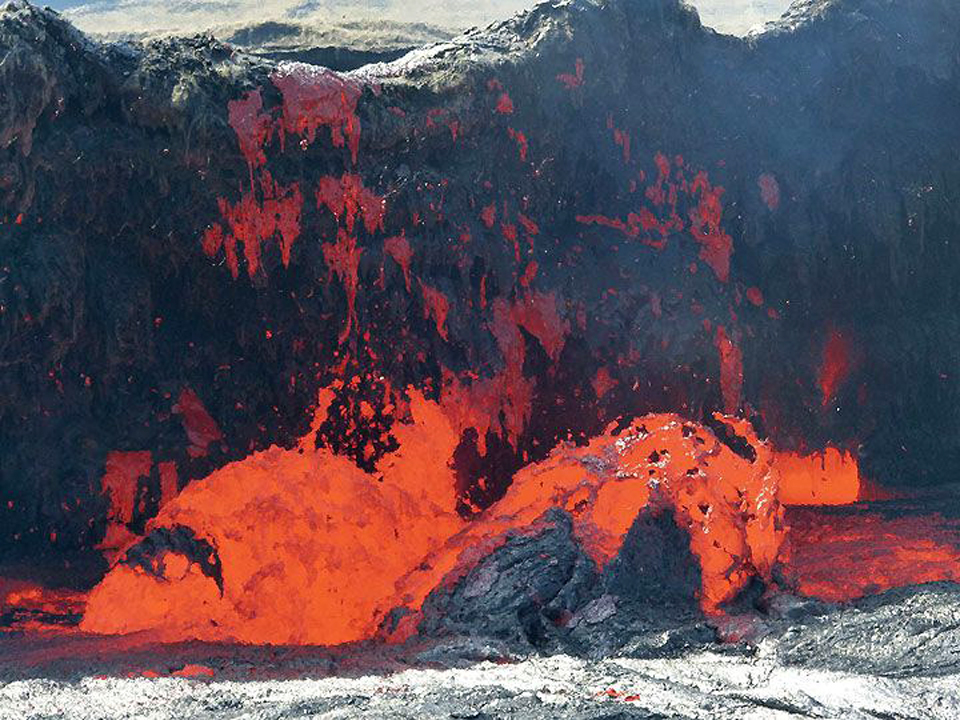 |
Figure 36. Fountains from the lake at the South Pit crater of Erta Ale splatter lava onto the crater rim on 19 November 2015. Photo by Ingrid Smet, courtesy of Volcano Discovery. |
Volcano Discovery reported that the lava overflowed the rim of the South Pit crater during the night of 15-16 January 2016, and covered the rim with a fresh crust of pahoehoe. An expedition leader reported that during 12-15 February 2016, the lake level had dropped 5-7 m. A visitor to the crater in April 2016 photographed the lake level several meters below the rim with active fountaining lava (figure 37).
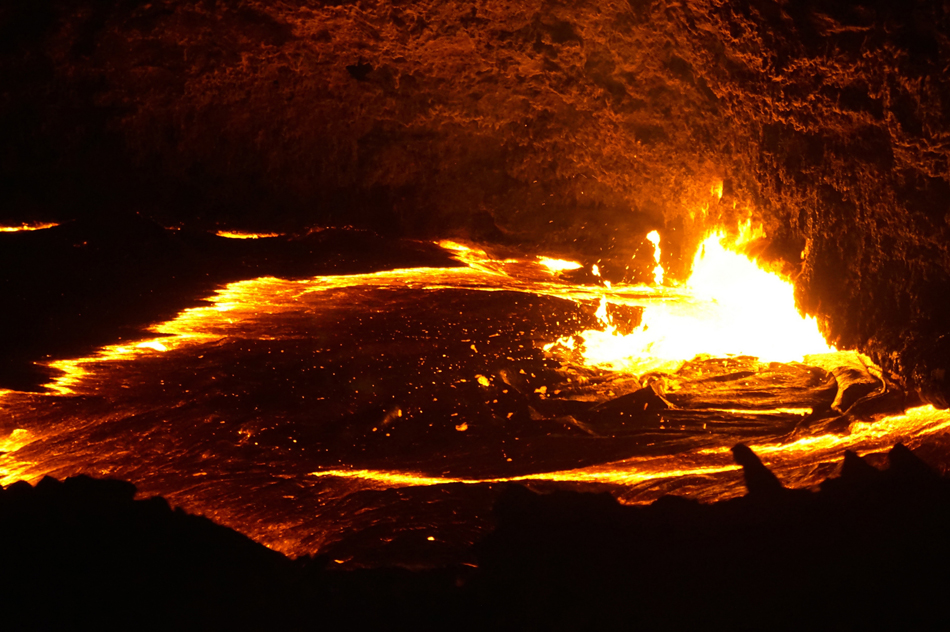 |
Figure 37. The boiling lava lake at the South Pit crater of Erta Ale on 3 April 2016. Photo by V, courtesy of Flickr. |
The southern pit crater began overflowing again at the beginning of November 2016, and covered significant parts of the surrounding caldera floor (figures 38 and 39). The overflow was observed at mid-day on 14 November by visitors from the Societe de Volcanologie Geneve (SVG).
By late December 2016, effusive activity was reported from both the North and South Pit craters, including activity at the South Pit crater overflowing beyond the surrounding summit caldera. An expedition during 29 December 2016-1 January 2017 observed changing activity from both craters inside the summit caldera (figure 40). During 29-31 December, the lake level at the South Pit crater fluctuated between 0.5 and 1 m below the rim. During this time lava fountains 2-3 m high were frequent along the South Pit crater rim, but it did not overflow. The caldera floor around the crater was covered with 2-3 m of fresh pahoehoe, over an area about 150 m in diameter. Activity at the North Pit crater had formed three hornitos, one of which was emitting lava.
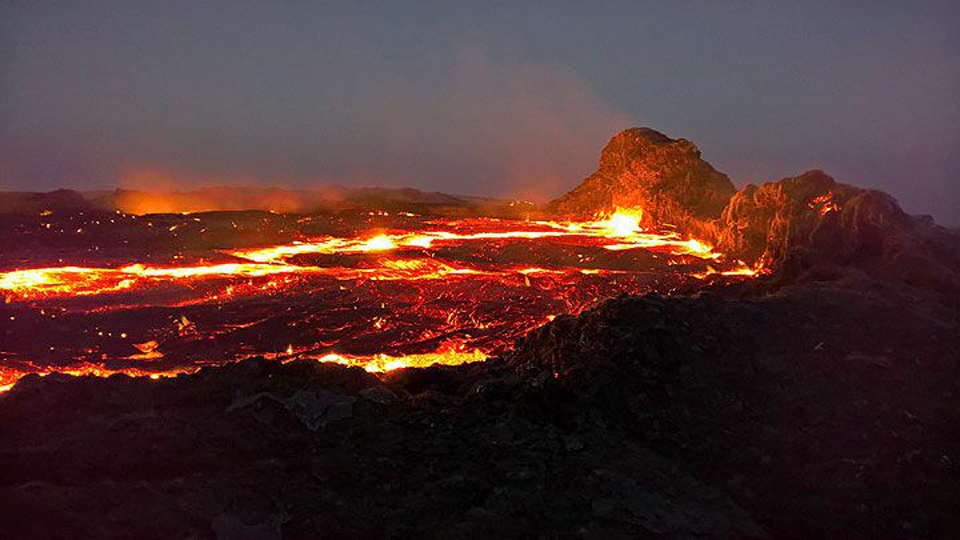 |
Figure 40. Erta Ale's lava lake at the South Pit crater on 29 December 2016. Photo by Jens Wolfram Erben, courtesy of Volcano Discovery. |
Activity during January-June 2017. Observations on 16 January 2017 at the North Pit crater showed remnants of two large hornitos surrounded by fresh lava flows (figure 41). During 16-20 January 2017, the lava lake at the South Pit crater underwent rapid and large variations, producing massive overflows and intense spattering. During the morning of 16 January the lake overflowed the W rim of the crater (figure 42); in the afternoon two lava rivers, reaching 500 m in length, appeared on the SW flank.
On 17 January around 1300, two overflows began on the South Pit crater rim. Two hours later, overflows appeared on the NE and N flank; lava was flowing over about 70% of the rim according to visitors (figure 43). They reported the speed of the lava flowing on the flank at 50-70 km per hour, covering about 1 km2 within the larger caldera. In the morning of 18 January, fresh, glowing lava covered the area around the South Pit crater 500-700 m in all directions (figure 44). Sporadic overflows occurred with lake levels fluctuating by 10-15 m for several days. During lower levels, Strombolian fountains reached 50-60 m above the lake.
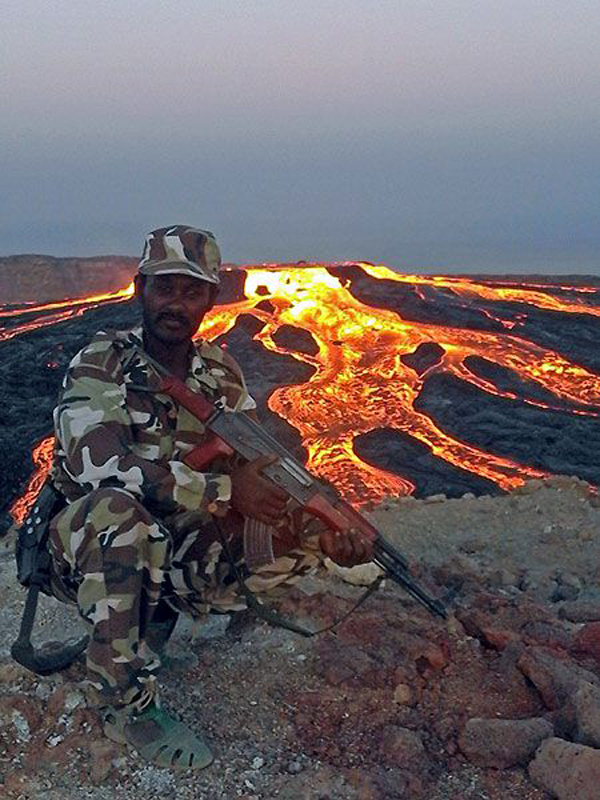 |
Figure 43. The lava lake at the South Pit crater of Erta Ale overflowing on all sides on 17 January 2017. Photo by Enku Mulugeta, courtesy of Volcano Discovery. |
On the evening of 20 January, explosions of very large gas bubbles were observed by Oliver Grunewald and reported by Culture Volcan, causing lava to spatter up to 30 m high. Parts of both of the craters in the Summit caldera began to collapse. At the North Pit crater, a new 20 m deep oval-shaped pit crater 150 x 30 m formed during the next 24 hours. A collapse at the South Pit crater doubled its size. This activity was accompanied by ash emissions that reached 700-800 m above the crater.
Volcano Discovery reported news from eyewitness reports of a fissure eruption beginning on 21 January 2017. Two fissure eruptions were visible on the SE flank, 3 and 4 km SE of the South Pit crater lava lake, in satellite imagery taken on 26 January 2017 (figure 45). The higher vent was located at about 650 m elevation, and the lower one around 400 m. The fissures created three distinct lava fields, one to the NE reaching about 3 km length, a smaller one to the W (about 1 km), and one to the SSE about 2 km long. The surface area covered by the first two (on either side on the northernmost fissures) was estimated to be about 1.5 km² (1,500,000 m²), while the southern flow covered about 0.35 km² (350,000 m²). As a result of the sudden draining of the magma into the new fissure zone, the lava lake in the South Pit crater was reported to have dropped by 80-100 m. Additional satellite imagery taken before and after the fissure eruptions began reveal the locations of the new flows on 23 and 27 January 2017 (figure 46).
After dropping about 100 m after the flank eruption began, the South Pit crater lake level rose again by mid-February to 40-50 m below its rim. By April 2017, activity still remained high; a new lava lake about 80 x 175 m in size had formed at the flank eruption site, and a growing lava field, about 1,500 m wide had reached 3.5 km NE of the original site. Geologists from Addis Abeba University who visited the site during 11-15 April 2017 noted two coalesced hornitos in the NE part of the South Pit crater, estimated to be 7 m high. The old lava lake was covered with cooled lava in a 200-m-diameter near-circular shape. Frequent surface collapse and lake-level changes occurred every 30 minutes, and lava fountains rose 25 m above the surface. The fresh lava surface around the crater rim had cooled enough to walk on it. The North Pit crater was still degassing, with several small hornitos growing in the center. The lake level at the new fissure (the SE Rift Zone) had dropped by about 10 m.
By early May 2017, the first lava lake at the SE Rift Zone had crusted over and a new lake was forming about 350 m E. A new breakout also started in early May, and was feeding a new flow field overlapping the previous one to the NE, more than 1,500 m long and over 500 m wide.
Satellite data. In addition to field observations of Erta Ale, valuable information is available from continuous satellite data. Thermal data from MODIS is processed by both the MIROVA and MODVOLC systems. The MIROVA thermal anomaly system recorded the high levels of heat flow and changes in location of the heat flow sources from late September 2015 through June 2017 (figure 47). The change in location and intensity of the heat flow in late January 2017 corresponds with the opening of the SE-flank fissure.
The MODVOLC thermal alert system managed by the University of Hawaii has captured persistent thermal alerts from Erta Ale for at least 10 years. When activity is moderate to high at the lava lakes in the pit craters, the signal is concentrated in those areas (figure 48). The reports of lava overflowing the south crater rim in January 2016 correspond to increased heat flow visible in the MODVOLC data. The dramatic changes in heat flow with the new fissure flows from the SE rift zone and subsequent new lava lake formation are apparent in MODVOLC images from January-May 2017 (figure 49).
Geological Summary. The Erta Ale basaltic shield volcano in Ethiopia has a 50-km-wide edifice that rises more than 600 m from below sea level in the Danakil depression. The volcano includes a 0.7 x 1.6 km summit crater hosting steep-sided pit craters. Another larger 1.8 x 3.1 km wide depression elongated parallel to the trend of the Erta Ale range is located SE of the summit and is bounded by curvilinear fault scarps on the SE side. Basaltic lava flows from these fissures have poured into the caldera and locally overflowed its rim. The summit caldera usually also holds at least one long-term lava lake that has been active since at least 1967, and possibly since 1906. Recent fissure eruptions have occurred on the N flank.
Information Contacts: NASA Earth Observatory, EOS Project Science Office, NASA Goddard Space Flight Center, Goddard, Maryland, USA (URL: http://earthobservatory.nasa.gov/); Tom Pfeiffer, Volcano Discovery (URL: http://www.volcanodiscovery.com/); Robert Simon, Sr. Data Visualization Engineer, Planet Labs Inc. (URL: http://www.planet.com/); MIROVA (Middle InfraRed Observation of Volcanic Activity), a collaborative project between the Universities of Turin and Florence (Italy) supported by the Centre for Volcanic Risk of the Italian Civil Protection Department (URL: http://www.mirovaweb.it/); Hawai'i Institute of Geophysics and Planetology (HIGP), MODVOLC Thermal Alerts System, School of Ocean and Earth Science and Technology (SOEST), Univ. of Hawai'i, 2525 Correa Road, Honolulu, HI 96822, USA (URL: http://modis.higp.hawaii.edu/); Societe de Volcanologie Geneve (SVG), Bulletin 161, January 2017.

